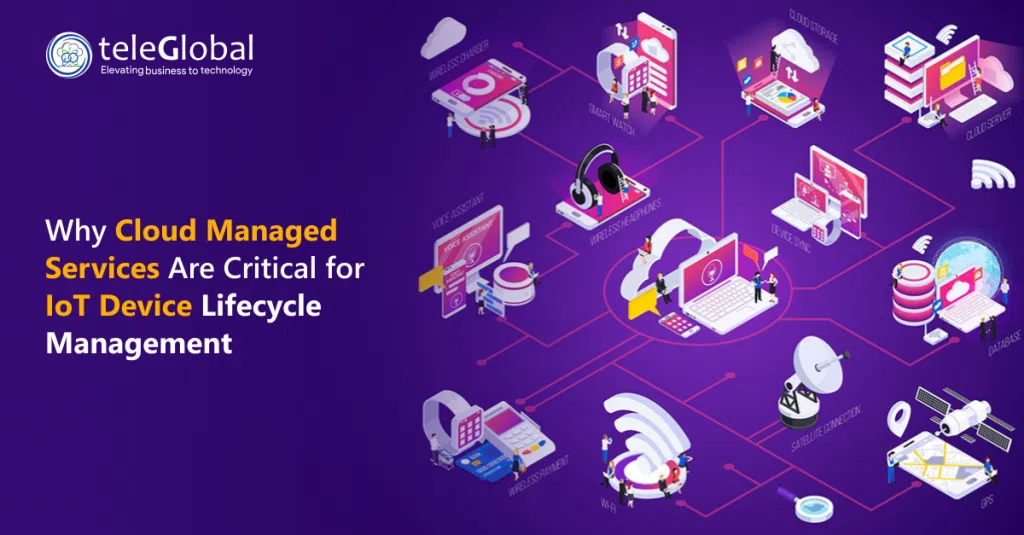
| Author: Ashish Kumar | Published: 18-Dec-2024 |
The Internet of Things (IoT) is driving innovation across every industry, from healthcare and manufacturing to smart cities and agriculture, in regions like the UAE, Europe, the US, and India. With billions of connected devices now in use, managing them effectively has become increasingly complex. Businesses in these regions need solutions that are scalable, secure, and cost-efficient to manage the full IoT device lifecycle, from deployment to decommissioning.
Cloud Managed Services have emerged as a pivotal solution, helping businesses streamline IoT device lifecycle management in today’s fast-evolving technological landscape. In this article, we’ll explain why cloud-managed services are essential for efficiently managing IoT devices, ensuring they remain secure, cost-effective, and high-performing throughout their lifecycle.
Managing IoT devices goes far beyond simply connecting them to a network. It involves a series of complex stages:
As businesses increase their use of IoT devices, managing them without a comprehensive solution can lead to inefficiencies, rising costs, and security risks. Cloud Managed Services offer a centralized, scalable, and automated approach to managing the entire lifecycle of IoT devices.
The world is rapidly adopting IoT technology, and businesses are deploying more devices than ever before. Traditional on-premise management solutions can’t keep up with the growing demand. As businesses scale their IoT operations, they need a solution that grows with them.
Cloud Managed Services are designed to scale effortlessly. Whether managing hundreds or millions of devices, cloud platforms can handle growth without the need for significant investments in hardware. Multicloud platforms further enhance scalability by providing businesses with flexibility and redundancy, ensuring continuous performance even as demand fluctuates.
This scalability helps businesses avoid the heavy costs associated with expanding their on-premise infrastructure and provides a pay-as-you-go model that only charges for the resources you actually use.
Managing a network of IoT devices across different locations can become overwhelming without a centralized platform. When devices are managed individually or using disparate systems, it becomes difficult to maintain control, leading to inefficiencies and missed opportunities for improvement.
Cloud Managed Services centralize control, enabling businesses to monitor their IoT networks from a single platform. With real-time monitoring, businesses can receive instant notifications of device failures, performance issues, or potential security breaches. Centralized control simplifies troubleshooting and minimizes downtime, ensuring that IoT devices operate at peak performance throughout their lifecycle.
Security is one of the biggest concerns for businesses using IoT devices, especially when they are connected to sensitive systems. IoT devices are often the target of cyberattacks, which can compromise data and disrupt business operations.
Cloud Managed Services provide advanced security features to protect IoT devices, including:
Moreover, cloud providers often offer built-in compliance tools that help businesses meet regulatory requirements such as GDPR, HIPAA, or SOC 2. This makes it easier for businesses to stay compliant and avoid costly penalties associated with data breaches or non-compliance.
One of the challenges of managing IoT devices is ensuring that they are running the latest software and firmware. Without proper updates, devices become vulnerable to security threats, and their performance can degrade over time.
Cloud Managed Services streamline this process by automating software and firmware updates across all connected devices. Rather than manually updating each device, businesses can schedule updates to occur automatically, ensuring that all devices stay current with the latest patches and security updates. This not only reduces the risk of vulnerabilities but also minimizes operational disruptions, allowing devices to continue functioning optimally.
Managing IoT devices in-house requires significant upfront investment in hardware, software, and IT staff. Businesses must also account for ongoing costs related to maintenance, security, and software updates.
By leveraging Cloud Managed Services, businesses can significantly reduce their capital expenditures. With cloud-based solutions, there’s no need for costly on-premise infrastructure or dedicated IT teams. The pay-as-you-go model makes it easier to manage costs, as businesses only pay for the resources they use, reducing overhead costs and eliminating unnecessary investments in underutilized hardware.
Additionally, businesses can optimize resource allocation, focusing on innovation and core business operations instead of worrying about device management.
Data loss is a serious concern for businesses relying on IoT devices. Whether due to hardware failure, cyberattacks, or system malfunctions, the ability to restore lost data quickly is essential to maintaining business continuity.
Cloud Managed Services offer reliable backup and recovery solutions for IoT data. By securely storing data in the cloud, businesses can ensure that they always have access to critical device information, even in the event of a failure. Cloud platforms make it easy to recover data quickly and restore devices to their previous state, minimizing downtime and maintaining operational continuity.
Consider a smart factory that uses IoT devices to monitor production lines, track equipment health, and collect environmental data. Without a cloud-managed solution, the factory would have to manage thousands of devices individually, apply updates manually, and handle security issues on its own.
This approach enables the factory to remain agile, cost-effective, and secure, ultimately increasing production efficiency and reducing operational risks.
As IoT continues to grow in scale and importance, businesses need a cloud-managed approach to IoT device lifecycle management. Cloud Managed Services offer the scalability, security, cost-efficiency, and automation needed to keep up with the growing demands of IoT operations. These services provide centralized control, enhanced security, and streamlined updates, making it easier for businesses to manage their IoT networks effectively.
At TeleGlobals.com, we offer Cloud Managed Services tailored to the needs of IoT businesses. Our expertise in cloud security solutions, cost optimization, and device lifecycle management can help you simplify your IoT operations and unlock the full potential of your connected devices.
Cloud Managed Services offer a centralized solution for monitoring, managing, and securing IoT devices throughout their lifecycle. These services provide scalability, real-time data processing, and automated updates, making it easier to manage large-scale IoT deployments.
Cloud Managed Services provide advanced cloud security solutions such as encryption, identity management, and anomaly detection to protect IoT devices from cyber threats. Cloud platforms also offer tools to ensure compliance with regulations like GDPR and HIPAA.
Cloud platforms use a pay-as-you-go model, allowing businesses to only pay for the resources they use. This eliminates the need for upfront investments in hardware and infrastructure, reducing capital expenditures and ongoing operational costs.
Cloud Managed Services offer data backup and recovery solutions that ensure IoT data is securely stored and easily recoverable in the event of a failure. This minimizes downtime and ensures business continuity.
A hybrid cloud combines on-premise infrastructure with cloud services, while a multi-cloud strategy uses multiple cloud providers for flexibility, redundancy, and cost optimization. Both approaches can improve IoT lifecycle management by offering more options for scaling and flexibility.
When looking for a Cloud Service Provider, choose one that specializes in IoT lifecycle management, cloud security, and data analytics. Check for experience in handling large-scale IoT networks and offering tailored solutions that fit your specific needs.
 close
close

Hi there! At TeleGlobal, we turn your cloud vision into AI-accelerated reality. What challenge can we help you solve?
Powered by ![]() teleBot
teleBot